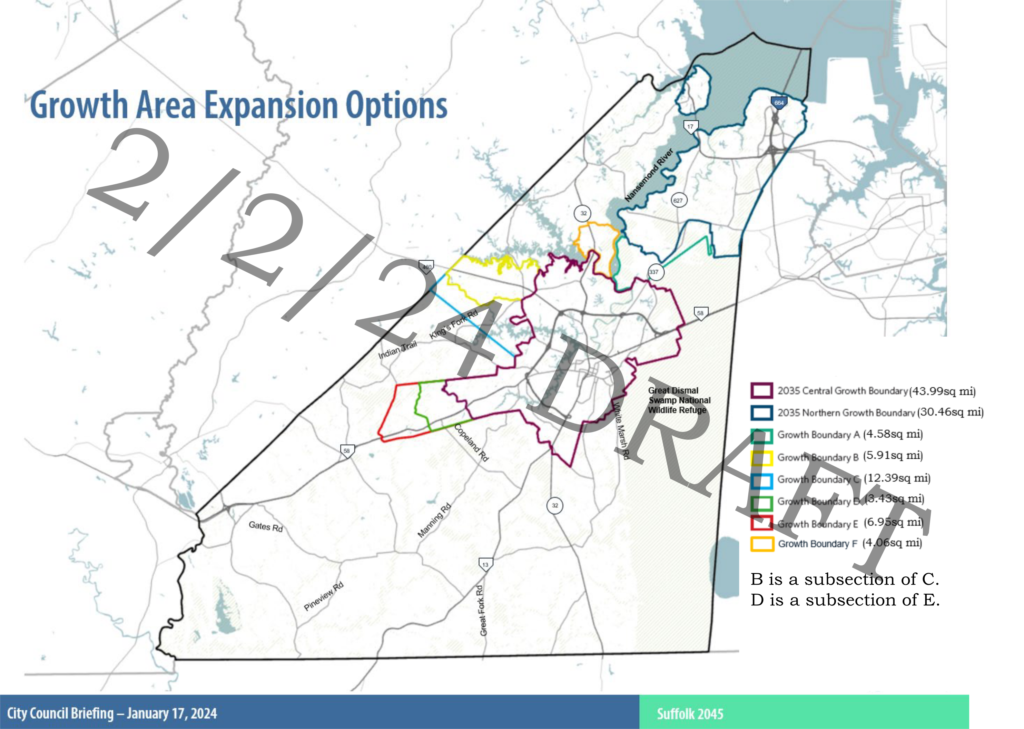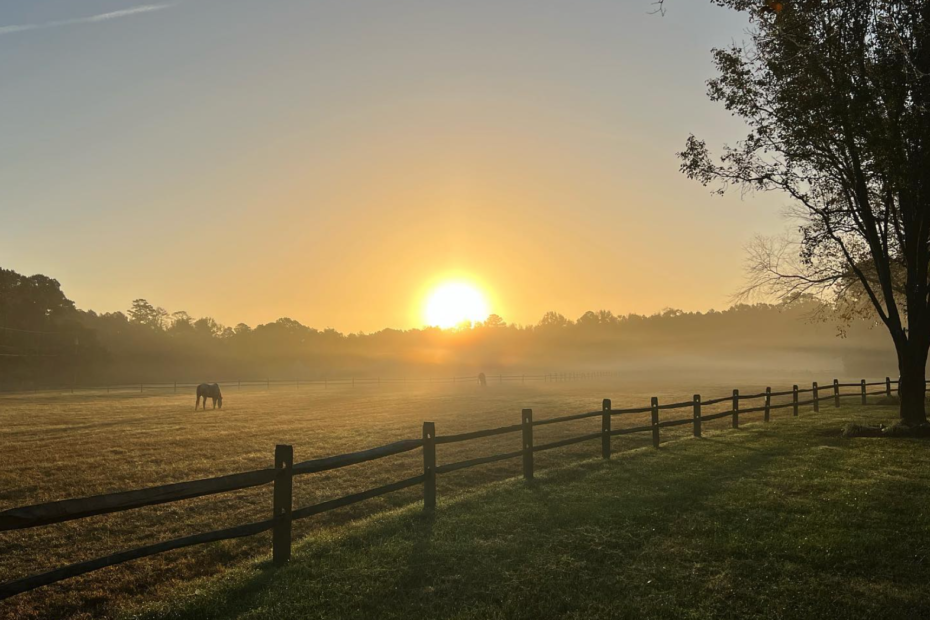We recently wrote about the City of Suffolk’s plan to increase its Growth Area by 24%. Now we want to explain why this is a short-sighted plan on the part of City Planners and why it is critical for our community to stop what will be a massive hit to our agricultural community and have negative impacts on our citizens for generations to come.
The City of Suffolk is 429 square miles, but 72 square miles of that is the Great Dismal Swamp National Wildlife Refuge (Source: City of Suffolk). While the refuge is an ecological and historical treasure for our state and the nation, none of the 72 square miles can be developed. That leaves 357 square miles of already developed and potentially developable land in the City of Suffolk. The current growth area is 74.5 square miles (about 21% of the non-swamp land in Suffolk). The Planning Department is recommending expanding the growth area by 18 square miles (a 24% increase to its current size) which would bring it to 92.5 square miles. That will create a total growth area that is equal to 26% of all non-swamp land in Suffolk.

Only 17% of all land in America is ideal for farming. (Source: Modern Farmer) As a country we have lost 11 million acres of farmland and ranchland between 2001-2016 due to development. (Source: American Farmland Trust) Further, 62% of all development has happened on agricultural land. (Source: Modern Farmer) As the world population grows, the natural resource of farmable land becomes increasingly valuable. The world’s population is expected to increase by 35% by 2050 and “nearly all new food production in the next 25 years will have to come from existing agricultural land.” (Source: National Geographic Magazine)
Those are just some quick facts to show that this problem is not localized to just Suffolk, which has lost 17% of its farmland in the last 20 years. (Source: Suffolk Agricultural Advisory Committee) This is a problem throughout the country. According to the 2022 Census of Agriculture, the number of farms in Virginia decreased from 43,225 in 2017 to 38,995 farms in 2022, losing about 500,000 acres of farmland. (Source: 2022 Census of Agriculture (Reported by On the Farm Radio)) That’s a 6.4% in just 5 years. Secretary of Agriculture Tom Vilsack, in response to the 2022 Census of Agriculture stated, “This survey is a wake up call…Are we okay with losing that many farms? Are we okay with losing that much farmland? Or is there a better way.” (Source: AgWire)
“This survey is a wake up call…Are we okay with losing that many farms? Are we okay with losing that much farmland? Or is there a better way.”
Here is why you should care about this loss of farmland:
Farmland keeps property taxes lower. In Lancaster County, Pennsylvania, they broke down the impact of the cost of services for agriculture, residential and commercial properties. For each $1 collected in property taxes for each type of land, the city has an associated cost of services. The results may surprise you. (Source: Lehigh County, Pennsylvania)
$1 of agricultural tax revenue = $0.36 spent in public service
$1 of commercial tax revenue = $0.99 spent in public service
$1 of residential tax revenue = $1.30 spent in public services
Turning farmland into commercial and residential land actually costs the city (or the taxpayers) more money. Cities lose money on residential properties because they require schools, improved roads, and other additional services such as water, sewers, police, fire, and medical. The city actually makes significantly more money on agricultural land than it pays in services. If citizens (and responsible city planners) want to save money, they should stop rezoning agricultural land to build houses and warehouses.
Other benefits of preserving our farmland (Source: Lehigh County, Pennsylvania):
It provides locally grown foods that are more nutritious and less expensive than food that has to be transported over long distances.
It improves water quality by filtering runoff water through topsoil versus going directly from paved surfaces into drainage. This is particularly important in Suffolk, home to many of the reservoirs that provide drinking water for so many people in Hampton Roads.
It benefits the environment by protecting against soil erosion, offsets greenhouse gas emissions, and provides habitat to many wildlife species.
Open farmland is more visually attractive and creates a higher quality of life for citizens.
Additionally, Agriculture is big business. Agriculture generates roughly $462 million of direct and indirect economic impact for Suffolk. (Source: Suffolk Agricultural Advisory Committee)
It is nearsighted planning that will destroy the valuable natural resource of Suffolk’s nutrient-rich farmland to build houses and warehouses. The huge expansion of the Growth Area in the upcoming Comprehensive Plan will facilitate this loss of farmland. Its destruction will be permanent and will be a loss to our city, our community, and future generations.
Let City Council know what you think about this new growth area: council@suffolkva.us
Michael D. Duman, Mayor
mayor@suffolkva.us
Phone: 757-514-4009
Lue R. Ward, Jr., Vice Mayor
(Nansemond Borough)
nansemond@suffolkva.us
Phone: 757-377-6929
Shelley Butler Barlow,
Council Member
(Chuckatuck Borough)
chuckatuck@suffolkva.us
Phone: 757-346-8355
Leroy Bennett, Council Member
(Cypress Borough)
cypress@suffolkva.us
Phone: 757-407-3750
Timothy J. Johnson, Council Member
(Holy Neck Borough)
holyneck@suffolkva.us
Phone: 757-407-0556
Roger W. Fawcett, Council Member
(Sleepy Hole Borough)
sleepyhole@suffolkva.us
Phone: 757-377-8641
John Rector, Council Member
(Suffolk Borough)
suffolk@suffolkva.us
Phone: 757-407-1953
LeOtis Williams, Council Member
(Whaleyville Borough)
whaleyville@suffolkva.us
Phone: 757-402-7100

For the sake of context, this article should include the fact that a decrease in the total amount of farmland is independent from the total level of agricultural production. According to the US Department of Agriculture, U.S. agricultural productivity increased at a rate of 1.46 percent per year from 1948 to 2021 at the same time that the amount of land and labor used for farming declined at annual rates of 0.45 percent and 1.93 percent, respectively. Thus, despite a decline in total land area dedicated to farming since 1948, total production today is nearly three times what it was then. (Source: https://www.ers.usda.gov/amber-waves/2024/september/u-s-agriculture-production-grew-steadily-from-1948-to-2021-as-productivity-increased/)
Even if it is true that “nearly all new food production in the next 25 years will have to come from existing agricultural land” this is far from an insurmountable problem. Farmers have been increasingly producing more with less, and they’ve been doing it for longer than most of Suffolk’s residents have been alive. This phenomenon shows no signs of stopping.